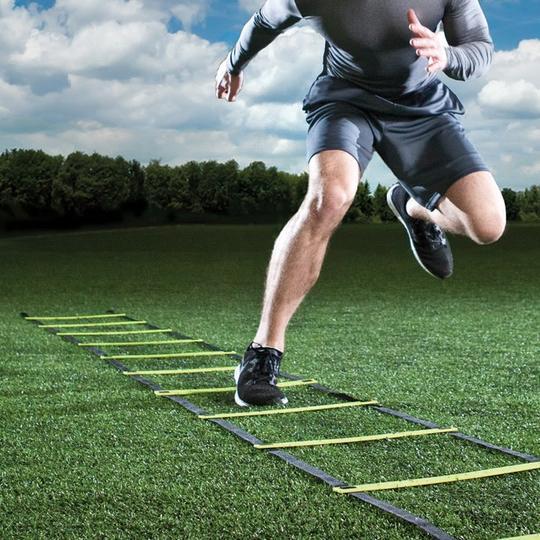Decrease Injury with Deceleration Training
Decrease Injury with Deceleration Training
Sports are becoming increasingly competitive. In order to even be considered as a potential starter, athletes have to prove themselves. Coaches look for not only the most skilled athletes but also the most athletic. Parents and athletes are more aware of the importance of strength and conditioning training than ever before. As a result, most young athletes are falling into three categories:
- Athletes that have not been exposed to structured strength training techniques or speed and agility protocol. This group is at risk of overuse and soft tissue injuries because their joints and ligaments are not resilient and are susceptible to strains, tears, and stress fractures.
- Athletes that have been exposed to strength and conditioning along with speed and agility training, but have not been taught by a professional. Learning improper movement patterns and stressing them with high loads is a dangerous combination and will lead to injury.
- Athletes that have been exposed to a progressive periodized strength program that is appropriate for their age and experience. This group will have a solid foundation of strength, coordination, speed, agility, and power. They will have the advantage of performance benefits and less injury risk.
If we break down sports or athletics into its simplest form, it is a series of complex movements through multiple planes. Some are predictable and some are unpredictable. In order to prepare for sports, athletes must be able to tolerate the forces produced in their sport. If the forces required in the sport exceed the athlete’s ability to produce or absorb that amount of force, they are at greater risk for injury. It is estimated that there are around 80,000 ACL injuries each year. Let’s look into why these injuries may be occurring.
In the sports performance industry athletes are attracted to buzz words like speed, explosiveness, power, and vertical jump. All of these terms focus on acceleration movements or concentric muscle contractions. Putting a disproportionate focus on power and explosiveness will lead to a deficit in the ability to properly control the body when decelerating. Training specifically in the acceleration phase will primarily use concentric movements. In the leg we find that the quadriceps will become over-dominant and create an excessive amount of stress on the ACL. Therefore, it is important that athletes train athletes to use the hamstrings and glutes when decelerating, should be in our top priorities.
A lot of trainers and coaches don’t teach proper deceleration or landing mechanics. They may assume athletes know how to slow down, stop, and land. Now, they may be right in that most athletes can execute that task. However, the better question is can they slow down, stop, or land “properly”? Research supports that there are IDEAL positions and angles that athletes can put themselves in that will allow them to significantly decrease risk for injury simply by being in the right position while cutting, sprinting, or landing from a jump.
In order for athletes to prepare for the demands of their sport, it is important to incorporate these three elements into training:
- Emphasize the end of the drill – When performing agility or sprint drills, athletes should intently come to a complete stop abruptly when ending the drill instead of jogging or coasting. To decelerate, lower the hips and slightly over reach by contacting the ground in front of the hips. This will help enhance breaking ability over time.
- Focus on force reduction deceleration technique – Start deceleration drills off with an agility ladder and only perform the drills at 70%. Really focus on digging the foot into the ground, coming to a complete stop, and maintaining low hips and proper body angle. Progress by increasing speed and more complex agility/plyometric drills.
- Add tempo into strength training – Emphasize the eccentric phase or the muscle lengthening phase of the lift. For example, instead of doing regular squats, descend down into the squat slowly for 3-10 seconds to work on controlling the load. Isometrics are also a great way to improve deceleration ability. Let’s use the same squat as an example. Descend down into the bottom of the squat and pause for 2-10 seconds before exploding upwards.
Linear Deceleration Technique
- Hips down – 45 degree angle
- Knees bent – Avoid <20 degrees of knee bend
- Lean back – Contact should be nearly 45 degrees. Opposite of power line
- Heel contact – Contact should begin with heel, roll to ball of foot, and press firmly into ground
- Multiple steps – Spreading the force out of multiple steps greatly reduces chance of injury

Deceleration Drills
- Set up cones 3 yards apart, sprint to the cones, decelerate into a lunge, backpedal to cones. Continue for designated sets/reps.
- Set up 3-5 hurdles, laterally run over the hurdles, focus on a deep pause for about 2 seconds when changing direction.
- Set up a ladder, run diagonally across the ladder, 2 feet in, 1 foot out. Focus on proper hip/knee angles on outside of ladder.
- Drop from a depth of 6”-18”, land simultaneously with both feet, very little/no hip drop, hips back, knees bent. Pause for 2 seconds.

